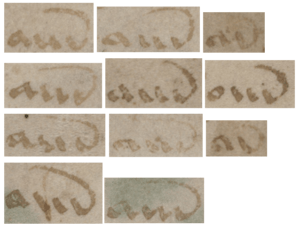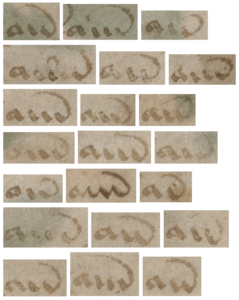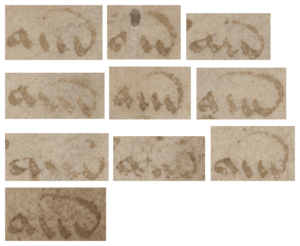For a change, I thought it might be interesting to take a fresh look at the -n words solely in f1r. If you recall Lisa Fagin Davis’ (2020) paper, she describes (p.173) how her five putative Voynich scribes write the -n glyph in different ways:
- Scribe 1: “The word- end [m] and [n] glyphs conclude with a backward flourish that stretches as far as the penultimate minim.“
- Scribe 2: “The final backstroke of [m] and [n] is short, barely passing the final minim.“
- Scribe 3: “The final stroke of [m] and [n] curves back on itself, nearly touching the top of the final minim.“
- Scribe 4: “The final stroke of [m] and [n] is tall, with only a slight curvature.“
- Scribe 5: “The [m] has a long, low finial that finishes above the penultimate minim.“
f1r is right at the start of Quire 1 (Q1), and is a Scribe 1 Herbal-A page (“Quires 1–3 are written entirely by Scribe 1”, p.175). So let’s have a look for ourselves:
f1r Paragraph #1
Personally, I’m not seeing a huge amount of scribal consistency here: some of these -n glyphs do indeed stretch as far as the “penultimate minim”, but others reach much further back or not as far back at all.
f1r Paragraph #2
Same for this (short) paragraph.
f1r Paragraph #3
Same for this (much longer) paragraph. Note that the 14th instance seems to have been emended by a later owner. Also, the 4th instance appears to be “airin” (a Voynich ‘word’ that voynichese.com says appears only four times), but where the loop of the terminal -n goes back as far as the first [i] glyph.
f1r Paragraph #4
Same for this paragraph, though (to be fair) the scribal -n flourishes are perhaps the most consistent here. Note that the 2nd instance has a wormhole running vertically through it, which (as Rene Zandbergen likes to point out) probably implies that this page spent a good amount of time close to a wooden book cover (because woodworms like eating wood, and don’t like eating vellum), now long gone.
Your thoughts, Nick?
On the one hand, I’m not at all against the idea of Lisa Fagin Davis’ proposed Five Scribes (even if it does sound to me not unlike the name of a medieval burger restaurant).
But on the other hand, when I look at the actual -n instances that appear on the very first page of the manuscript all side by side, I’m not getting a hugely consistent scribal vibe off that ensemble.
At the same time as all this, it’s hard for me to look at a block of words such as “dain oiin chol odaiin chodain” with four different scribal -n flourishes and not think that something pretty fishy is going on. My code-breaking third eye keeps telling me that something is being hidden in plain sight (perhaps four plaintext digits, so maybe a date?), but the precise details evade me (and everyone else). Oh well.





As someone with awfully inconsistent handwriting, I am well aware that letter shapes might be variable without implying a different meaning. This might especially be true for swoopy flourishy bits… I hope I am never in a position where my signature needs to be checked, because I don’t think I’ve ever made the exact same loop twice.
For the same reason, I believe Lisa’s approach cannot have been to look for fixed rules, but rather for a kind of average. This scribe tends to aim far over the minim cluster, while the other one tends to loop down quickly, aiming towards the closest minim. But sometimes his swoop might come out longer or more horizontal, so it is necessary to look at the average situation for a page.
If this could somehow be done, it would certainly be a useful exercise, but to do it properly would be very time consuming.
Koen: I think there’s a need to be careful about “the swoopy flourishy bits”, for if you assume that they can only be (incidental, scribal) flourishes, then you’ll end up concluding that too (which would be a circular argument). Regardless of the degree to which Lisa looked “for a kind of average”, by the time she reduced her argument to the (very much simplified) five scribe headlines I listed at the top of this post, any shred of nuance was lost. Personally, I don’t think her description of how Scribe 1 properly matches the variations of -n that we see on f1r, and so that was the point of my post: and it would be a shame if Voynich research were to be yet again blighted by well-meaning (over)simplifications that lose the sense of frustrating variation that pervades just about every line. The map is not the territory, and the scribes are not the vibes etc.
I can’t imagine Lisa Fagin Davis being so easily fooled. I think she probably has more reasons than that.
At first glance, everything looks about the same to me. Let me take one more step.
I take EVA S and EVA r. They also have an arch. With these you are almost forced to write them in 2 moves. Both from top to bottom. The nib is drawn twice per character.
With ‘n and m’ it also looks as if you are drawing upwards in one go. It looks round rather than pointed at the bottom.
But do they really all pull up from the bottom, or is there one where it pulls down from the top and hangs on?
I have to enlarge it a lot to see anything.
Translated with DeepL.com (free version)
Bruce Schneier in his August 15th Cryptogram, https://www.schneier.com/crypto-gram/archives/2024/0815.html, has just commented on Davis, who is prominent in the long article in September’s The Atlantic https://www.theatlantic.com/magazine/archive/2024/09/decoding-voynich-manuscript/679157/
AI + Voynich 408 + J.Zlatoděj
https://medium.seznam.cz/clanek/josef-zlatodej-voynichuv-rukopis-ai-a-josef-zlatodej-86659
Andy,
In that same ‘Cryptogram’ (August 15th), Bruce Schneier reports some horrifying-sounding statistics from Cloudflare.
What he doesn’t seem to know is that anyone who tries to block advertisements is automatically deemed a ‘malicious site’ and blocked by Cloudflare, in effect punishing anyone not wanting to be bombarded with unwanted ads by denying them access to any site that Cloudflare monitors. I’m sure they also catch a lot of nasties as well, but their system doesn’t work too well.
The big problem with artificial intelligence. He can’t count well.
https://medium.seznam.cz/clanek/josef-zlatodej-voynichuv-rukopis-umela-intelligence-a-vagina-90629
It will be very difficult for AI to understand the text of the manuscript and the images drawn in it. I tested how she is able to identify, for example, how the moon is painted on the upper left rosette. And how Ai is able to determine the correct number of cartoon crescent moons. It was a big disaster. It will be very difficult if not impossible for AI to understand handwriting. But he’s trying. I will try to push her further and hopefully the work will be successful. I have enough time for that for now.
Hopping down the bunny trail
Welcome to the warren, Diane.
papyrus was used for 5000 years and was rolled up in scrolls.
this was a problem as the only thing that would stick was ink
(stain) paint would flake off with use.
Crateuas and Dioscorides would have used scrolls. how do we
know ?
The Herculaneum Scrolls date from 79ad and would include
Crateuas time. Dioscorides came later under emperors Nero,
Caligula, and Claudius.
The first codexes came in the third and fourth century.
papyrus was replaced around the 11th or 12th century with
parchment and paper.
foreshadowing
1. The boys from Siena
Pier Andrea Mattiol and Gherardo Cibo
2. Get $ 700,000 to read some books.
3. Rag pickers
Explor,
Yes, I think I take your point. Sounds as if the poor, faintly hysterical Mr. memer (me-me-r) is recycling one of his old ‘artificial intelligence’ memes. I’ve observed that he’s a bit obsessive-compulsive about typos and numbers, and has a very short attention span when it comes to absorbing new information.
So I write long essays and sprinkle them with vague numbers, such as “about a decade” in one place and “thirteen years” in another place. 😀
Poor guy. His one aim is to be royalty, with everyone in the room treating him deferentially while (so to speak) he lifts their wallet while they’re bowing or while he’s pretending to pat them on the back. Still, fair’s fair. He’s been one of my more constant readers, even if he has difficulty processing the information and has to ask someone else what *they* think before being able to know what he thinks. Of course, who wouldn’t be flattered to have their opinion asked? So it goes.
At the moment he’s annoyed because he can’t find much to pilfer, but it looks as if he’s having to flick back through his own memes or others’ speculations that he stored away for use as needed. Oh well..
more than a decade… ‘about thrteen years’… ‘since 2009’… 😀 😀